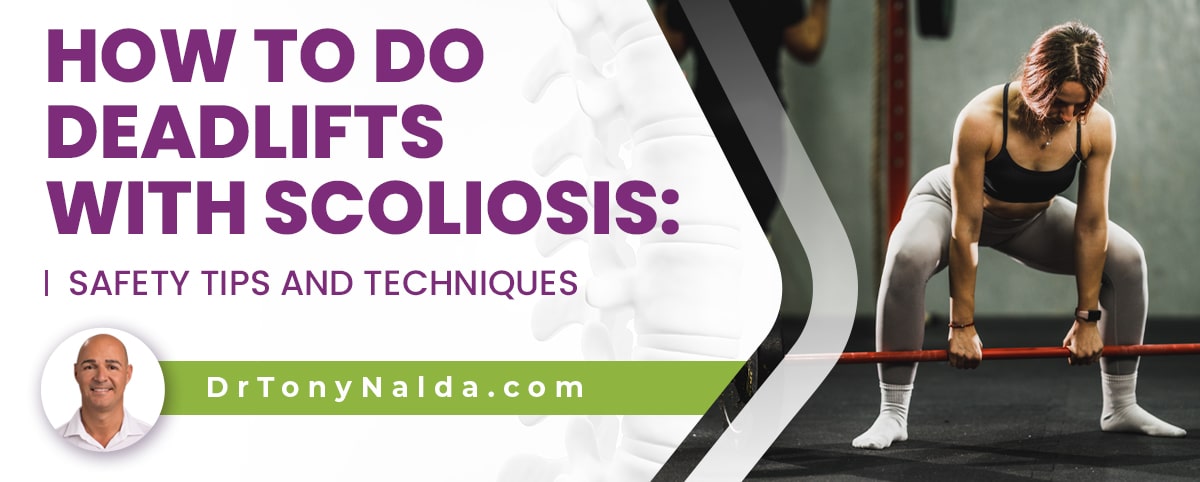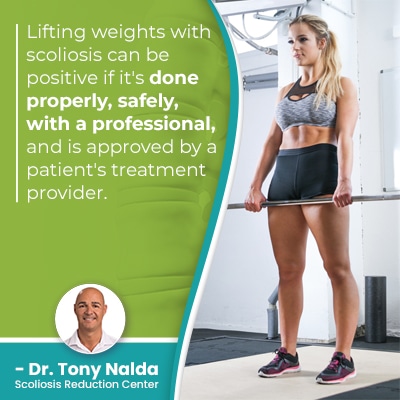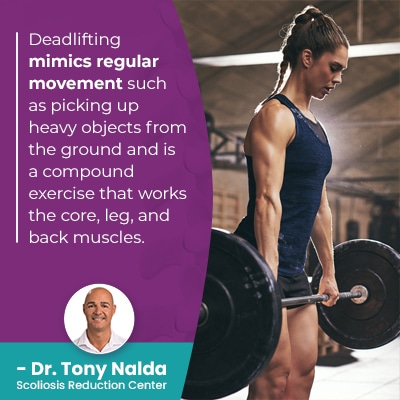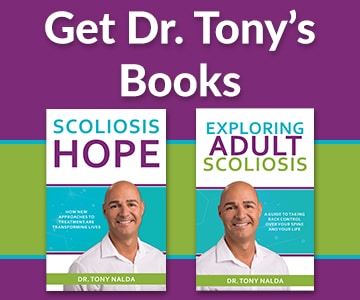How to Do Deadlifts with Scoliosis: Safety Tips and Techniques

When it comes to lifting weights with scoliosis, each patient's individual case has to be assessed. With guidance and approval, lifting weights can be good for people with scoliosis. It's not just the spine that has to support its healthy curves and alignment, but also the role of the spine's surrounding muscles to provide crucial spinal support and stability.
Deadlifting weights straight above the head can be harmful for people with scoliosis because it can strain the spine, but regular deadlifting may be safe with modifications and awareness. Muscle strengthening is also a key facet of nonsurgical scoliosis treatment.
Let's start with why certain activity restrictions for people with scoliosis are in place.
Table of Contents
Activity Restrictions
Every case of scoliosis is unique. Not only are there different severity levels, there are different types with unique characteristics and treatment needs.
The most important factors that shape a patient's experience with scoliosis include patient age, condition type, severity, and curvature location.
The complexity of scoliosis necessitates the complete customization of treatment plans, and activity recommendations/restrictions are a big part of that.
It's important that patients understand the fluidity of scoliosis; it's not a static condition and is likely to change over time, so assessing which activities are safe, should be avoided, or approached with caution can change over the course of a patient's treatment/scoliosis-journey.
As scoliosis causes the spine to bend and twist unnaturally, the spine can become weak and more vulnerable to injury.
People with scoliosis have to practice a spine- and scoliosis-friendly lifestyle to protect their spine's strength, health, and function, and in some cases, activity restrictions are a part of that.
In addition, certain activities can interfere with treatment, and weight lifting maneuvers that are unsafe can introduce more compression and adverse spinal tension to an already-strained spine.
Activity restrictions are determined by a patient's treatment provider; again, each case is different so what's deemed safe for one patient might not be safe for another.
Straining the Spine
Common activity restrictions include activities/sports that involve repeated shock from impact as this can compress the spine, weaken it, and strain it.
Activities that overuse one side of the body are also generally not recommended as they can exacerbate the condition's asymmetrical effects; a muscular imbalance is a common condition effect.
Sports and exercises that involve hyperextending the spine and are based on symmetrical movement like dance and gymnastics are also not commonly recommended.
Scoliosis introduces a lot of uneven forces to the spine, its surrounding muscles, nerves, and the entire body, and some common symptoms of scoliosis include postural deviation and pain (more common in adult scoliosis).
Scoliosis can range from mild scoliosis to moderate, severe and very severe cases, and the more severe a condition is, the more likely activity restrictions become.
So where does weightlifting come in?
Lifting Weights With Scoliosis
 Lifting weights with scoliosis can be positive if it's done properly, safely, with a professional, and is approved by a patient's treatment provider.
Lifting weights with scoliosis can be positive if it's done properly, safely, with a professional, and is approved by a patient's treatment provider.
Scoliosis causes certain vertebrae in the spine to bend and twist unnaturally, and as a progressive condition, the nature of scoliosis is to get worse over time.
So where a person's scoliosis is at the time of diagnosis doesn't mean that's where it will stay, along with its symptoms and related activity restrictions.
Lifting weights with scoliosis can help in a number of ways, when deemed safe and appropriate; it can help keep the spine strong, and it can also keep its surrounding muscles strong and balanced.
In fact, physical therapy and scoliosis-specific exercises, along with reducing the curve and improving posture, has the goal of improving muscle strength and addressing any related muscle imbalances.
Deadlifting With Scoliosis
Deadlifting is a type of weight lifting for strength training; typically, it involves a barbell being lifted off the ground by hinging the hips and extending the lower body.
There is also deadlifting straight over the head, and in most cases, this is not recommended for scoliosis.
 Deadlifting mimics regular movement such as picking up heavy objects from the ground and is a compound exercise that works the core, leg, and back muscles.
Deadlifting mimics regular movement such as picking up heavy objects from the ground and is a compound exercise that works the core, leg, and back muscles.
Important Deadlifting Tips and Techniques
Many activities are still safe for people with scoliosis if they are performed properly and under the watchful eye of a professional.
If deadlifting is deemed appropriate, the following tips can help minimize the risks:
Focus on the hips: the deadlift starts with bending at the hips, and the back should be held straight and the core should be engaged.
Grip the bar properly: grip the barbell with the palms either facing the body, or facing away from it.
Holding the back flat: it's important that the back is held in a flat position for the entire movement so stress is evenly distributed and absorbed throughout.
Pushing the feet into the floor: when deadlifting, the feet need to be pressed into the floor so the hips and knees can be fully extended and the spine can be held in a straight and neutral position.
Consult a scoliosis personal trainer or physical therapist: this one might be the most important. Don't attempt any type of deadlifting or any weight training program without the approval and assistance of a professional to ensure proper form.
Gradually increase weight amounts: when adding deadlifting into an exercise regime, start with low weights and increase gradually; this helps ensure the back muscles and spine are being strengthened gradually and limits the risk of injury and strain.
Listen to how your body responds: if you are experiencing pain during or after deadlifting, stop immediately and adjust your form until the movement no longer causes pain and discomfort.
Safe Activities for People with Scoliosis
It's important to understand that many activities are safe for people with scoliosis and while it's important for everyone to stay active, for people with scoliosis, it can be particularly beneficial.
Staying active can mean a spine that's stronger and more flexible and one that's surrounded by strong supportive and balanced muscles.
Safe activities for scoliosis include those that don't overuse one side of the body, place the spine in unnatural positions, involve hyperextending the spine, and/or repeated shock from impact.
Safe activities for scoliosis are those that can increase spinal flexibility, making it more responsive to treatment, improve posture, and/or muscle balance and symmetry.
Safe activities for scoliosis will vary from person to person, but generally, walking, swimming, certain yoga poses, and road-cycling are considered low impact, encourage good posture, and can improve flexibility and strength.
There was a time when the place of exercise was questioned in scoliosis treatment, but we now know that not only can it help prepare the spine and body for treatment, it can make it more responsive and actually help correct the unnatural spinal curve.
In fact, there are entire exercise-based approaches to treating scoliosis such as the Schroth method and SEAS (Scientific Exercises Approach to Scoliosis).
When scoliosis-specific exercise is combined with other forms of corrective treatment such as chiropractic care, physical therapy, corrective bracing, and rehabilitation, it can help with strengthening the spine and its surrounding muscles.
Conclusion
The first step to doing deadlifts properly, for people with scoliosis, is to have the exercise approved by a patient's treatment provider, and with help from a professional, ensure proper form is followed.
As deadlifting involves lifting weights straight off the ground and sometimes over the head, this can strain the spine if not performed properly and can be particularly dangerous for those with spinal conditions like scoliosis.
When it comes to deadlifting, making sure the spine is held straight, the bar grip is strong, the hips are engaged, and the feet are pressing into the floor, and for most people with scoliosis, lifting weights straight over the head should be avoided.
When deadlifting with scoliosis, it's important to make sure the exercise is performed under the watchful eye of a personal trainer or physical therapist, ideally someone who specializes in scoliosis.
Deadlifting can be helpful for people with scoliosis by keeping the overall body and core strong. Increasing core strength is important for scoliosis patients because it means the spine is surrounded by strong muscles for support and stability.
Here at the Scoliosis Reduction Center®, treatment plans are customized and nonsurgical, and exercise and guidance on how to find the ideal activity level is a key focus for our scoliosis patients.
We want to correct the scoliosis on a structural level and build muscle for increasing core strength and stability, and for patients interested in deadlifting, if approved by a treatment provider, modifications can often be made to ensure its safety.
Dr. Tony Nalda
DOCTOR OF CHIROPRACTIC
After receiving an undergraduate degree in psychology and his Doctorate of Chiropractic from Life University, Dr. Nalda settled in Celebration, Florida and proceeded to build one of Central Florida’s most successful chiropractic clinics.
His experience with patients suffering from scoliosis, and the confusion and frustration they faced, led him to seek a specialty in scoliosis care. In 2006 he completed his Intensive Care Certification from CLEAR Institute, a leading scoliosis educational and certification center.
About Dr. Tony Nalda
 Ready to explore scoliosis treatment? Contact Us Now
Ready to explore scoliosis treatment? Contact Us Now





